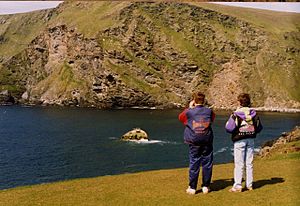MV Braer facts for kids
Quick facts for kids History |
|
|---|---|
| Name | Braer |
| Owner | Braer Corporation |
| Operator | Canadian Ultramar Ltd |
| Builder | Oshima Shipbuilding Co Ltd, Nagasaki, Japan |
| Launched | 31 May 1975 |
| Homeport | Monrovia, |
| Identification | IMO number: 7377220 |
| Fate | Ran aground near Quendale, Shetland, Scotland, in 1993 |
| General characteristics | |
| Type | Oil tanker |
| Tonnage | 89,730 DWT |
| Length | 241.51 m |
| Draft | 14.15 m |
| Installed power | Sumitomo-Sulzer 7RND90 (20,300 bhp) |
| Propulsion | Single shaft; fixed pitch propeller |
| Speed | 14.5 knots (26.9 km/h; 16.7 mph) |
| Crew | 34 (on last voyage) |
The MV Braer was a large oil tanker. In January 1993, it got stuck during a big storm. This happened near Shetland, Scotland. A week later, the ship broke apart. This was during one of the strongest storms ever seen in the North Atlantic Ocean. It was called the Braer Storm of January 1993.
Contents
Why the Ship Lost Power
After the ship was lost, an investigation took place. It was found that the ship lost power on January 3. This happened because seawater got into the ship's heavy fuel oil. A pipe on the deck broke during the storm. This allowed seawater to enter the fuel tanks through broken air vents. When the ship lost power, the crew could no longer control it.
The Braer Incident: A Timeline
Early Morning Distress Call
At 5:19 AM on Tuesday, January 5, 1993, the Lerwick coastguard received a call. They were told that the tanker Braer had lost engine power. The ship was on its way from Bergen, Norway, to Quebec, Canada. It was carrying 85,000 tonnes of Gullfaks crude oil.
The crew said the ship was not in immediate danger. Its estimated location was about 10 nautical miles (19 km) south of Sumburgh Head. However, this first position was off by 5 nautical miles (9 km). The ship was drifting in very strong winds. These winds were blowing at 24 to 33 meters per second. This is equal to a Beaufort scale 10–11 storm.
Rescue Efforts Begin
The coastguard quickly called for rescue helicopters. These came from Sumburgh and RAF Lossiemouth. They also looked for local tugboats that could help. The coastguard suggested that people who were not essential should leave the ship. The captain agreed.
Fourteen of the 34 crew members were taken off the ship. A helicopter from Sumburgh rescued them at 8:25 AM.
Drifting Towards Land
By 8:50 AM, there was a fear that the ship would hit land. It looked like it might run aground near Horse Island. The coastguard remembered the Aegean Sea incident. That ship caught fire shortly after getting stuck.
Because of this, the coastguard convinced the Greek Captain Alexandros S. Gkelis to leave the ship. But strong local currents pushed the Braer against the wind. It missed Horse Island and drifted towards Quendale Bay.
Attempts to Tow the Ship
The anchor handling vessel Star Sirius arrived at the scene. They decided to try and tow the Braer. There was a delay of 90 minutes. This was due to a mix-up in communication between the local police and the coastguards.
However, the captain and some crew members were then flown back to the ship by helicopter. They tried to attach a tow line. But their efforts were not successful.
Ship Runs Aground
At 11:19 AM, it was confirmed that the Braer had run aground. It was stuck at Garths Ness. Oil was seen flowing into the sea right away. At this point, the rescue team trying to help were also rescued by helicopter.
Impact on the Environment
The oil the Braer was carrying was called Gulfaks crude. This type of oil is lighter than other North Sea oils. It also spreads out more easily and breaks down faster. This, along with some of the worst storms in Shetland, helped. The waves and evaporation naturally broke up the oil. This stopped the spill from causing even greater damage to the shore.
However, Gulfaks crude has more volatile compounds. This might be why many seals in the area had breathing problems.
Protecting the Wreck Site
On February 8, 1993, the Braer wreck was given a special status. This was under section 2 of the Protection of Wrecks Act 1973. This part of the law is used for dangerous wrecks. It was only the second time this part of the Act was used. The site was marked as dangerous because of the oil. This special status was removed on October 7, 1994, after the oil had spread out.
Remembering the Braer
In 1995, the British folk-rock band Fairport Convention released an album. It was called Jewel in the Crown. This album included a song called "The Islands." It was written by Ralph McTell and Maartin Allcock. The song tells the story of the Braer wreck. It describes the sea as a protector of the Shetland Islands.


